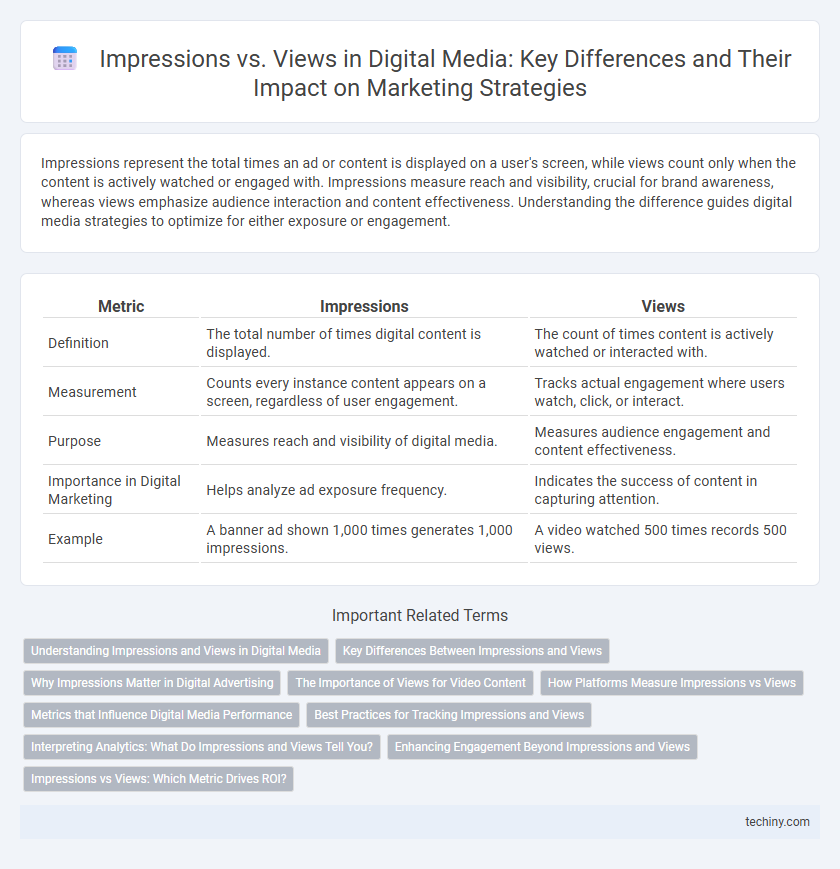Impressions represent the total times an ad or content is displayed on a user's screen, while views count only when the content is actively watched or engaged with. Impressions measure reach and visibility, crucial for brand awareness, whereas views emphasize audience interaction and content effectiveness. Understanding the difference guides digital media strategies to optimize for either exposure or engagement.
Table of Comparison
| Metric | Impressions | Views |
|---|---|---|
| Definition | The total number of times digital content is displayed. | The count of times content is actively watched or interacted with. |
| Measurement | Counts every instance content appears on a screen, regardless of user engagement. | Tracks actual engagement where users watch, click, or interact. |
| Purpose | Measures reach and visibility of digital media. | Measures audience engagement and content effectiveness. |
| Importance in Digital Marketing | Helps analyze ad exposure frequency. | Indicates the success of content in capturing attention. |
| Example | A banner ad shown 1,000 times generates 1,000 impressions. | A video watched 500 times records 500 views. |
Understanding Impressions and Views in Digital Media
Impressions represent the total number of times an ad or content is displayed on a screen, regardless of user interaction, while views indicate the number of times a user actively watches or engages with a video or digital content. Understanding the distinction between impressions and views is crucial for accurately measuring campaign reach and user engagement levels in digital media strategies. Metrics such as viewability rates, click-through rates, and attention time complement impressions and views to provide a comprehensive analysis of digital content performance.
Key Differences Between Impressions and Views
Impressions measure the number of times digital content is displayed on a screen, regardless of whether it is clicked or watched, while views indicate the count of times a user actively watches or interacts with the content. Impressions provide insight into potential reach and brand exposure, whereas views reflect actual user engagement and content consumption. Understanding these differences is crucial for optimizing digital media campaigns and accurately assessing performance metrics.
Why Impressions Matter in Digital Advertising
Impressions in digital advertising quantify how often an ad is displayed, providing critical insights into brand visibility and reach across platforms. Unlike views, which measure active engagement or interaction, impressions track passive exposure, helping advertisers gauge the potential audience size and frequency of ad delivery. This data is essential for optimizing campaign strategies, improving targeting accuracy, and maximizing return on investment by ensuring ads are seen by the intended demographic.
The Importance of Views for Video Content
Views provide a crucial metric for video content, directly reflecting genuine audience engagement and watch time, unlike impressions which only count ad or content appearance on screens. Higher view counts signal content relevance and quality, boosting algorithmic promotion on digital media platforms such as YouTube and Facebook. Measuring views enables marketers to optimize video strategies, improve targeting accuracy, and increase ROI through focused audience interaction.
How Platforms Measure Impressions vs Views
Impressions measure the total number of times an ad or content is displayed on a user's screen, regardless of interaction, while views track how many times a user actively watches or engages with the content, often requiring a minimum duration for counting. Platforms like Facebook and Instagram count impressions each time an ad loads on a feed, but views only register after users watch videos for a specific threshold, typically three seconds or more. Google Ads differentiates impressions by ad visibility within viewable area and views through video interactions, offering granular insights into user engagement versus mere exposure.
Metrics that Influence Digital Media Performance
Impressions represent the total number of times digital content is displayed, while views indicate the actual count of users who actively engage with the content by watching or interacting. Metrics such as click-through rate (CTR), viewability, and engagement rate further influence digital media performance by measuring audience interaction and content effectiveness. Optimizing for a balance between high impressions and meaningful views ensures better targeting, brand awareness, and conversion potential in digital marketing campaigns.
Best Practices for Tracking Impressions and Views
Accurately tracking impressions and views requires implementing reliable analytics tools that distinguish between user exposure and engagement metrics. Use pixel tracking and server logs to capture every ad impression, while viewability standards such as the Media Rating Council (MRC) guidelines ensure that views represent actual user attention. Regularly auditing data with platforms like Google Analytics or Adobe Analytics helps maintain precision and optimize campaign performance based on verified impressions and active views.
Interpreting Analytics: What Do Impressions and Views Tell You?
Impressions represent the total number of times your digital content is displayed, indicating exposure and potential reach, while views count the instances where users actively engage by watching or clicking the content. Analyzing impressions helps gauge brand visibility across platforms like social media and websites, whereas views measure user interest and content effectiveness. Understanding the ratio of views to impressions reveals audience engagement levels, informing data-driven decisions for optimizing digital media strategies.
Enhancing Engagement Beyond Impressions and Views
Impressions measure how many times content is displayed, while views indicate active user engagement through actual content consumption. Enhancing engagement requires shifting focus from surface-level metrics to deeper interactions such as click-through rates, time spent on content, and social shares. Leveraging data analytics to optimize content relevance and user experience drives meaningful engagement beyond mere impressions and views.
Impressions vs Views: Which Metric Drives ROI?
Impressions quantify how often digital content is displayed, measuring potential reach, while views indicate active engagement by users who actually interact with or watch the content. In driving ROI, views often hold more value as they reflect genuine user attention leading to higher conversion potential, whereas impressions primarily assess brand awareness. Marketers should prioritize tracking views alongside other engagement metrics to optimize campaigns for tangible business outcomes.
Impressions vs Views Infographic

 techiny.com
techiny.com